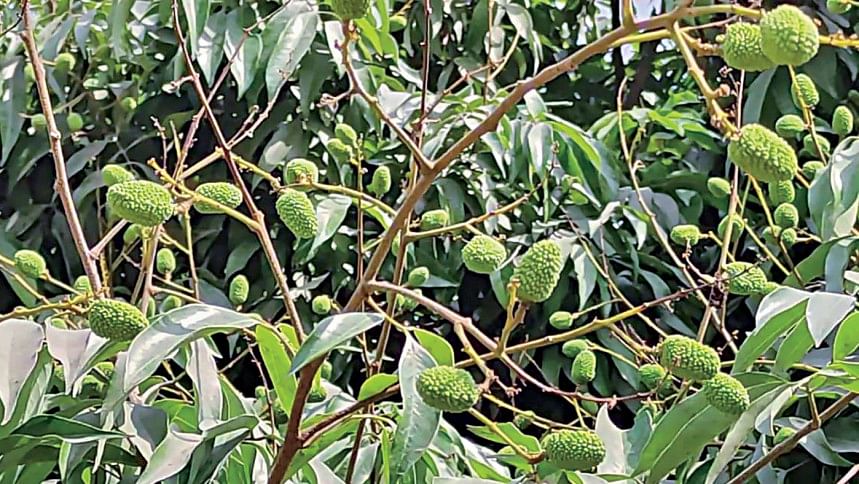Litchi farmers fear lower yields this year

Litchi farmers are concerned about potentially lower yields this year due to poor weather conditions, which hampered the flowering and budding stages of the fruit.
Litchi is grown on about 26,000 hectares of land all over Bangladesh but the highest cultivation is seen in Dinajpur, Pabna and Jashore, according to the Department of Agricultural Extension (DAE).
Dinajpur is the biggest producing region with roughly 5,000 hectares being used to grow the fruit while Pabna comes in second with 3,100 hectares.
Of the various species of litchi under cultivation, Bedana is the most popular while the Bombay, Madrazi, Hariya and China-1, 2 and 3 varieties also have high demand.
Litchi trees usually start flowering between February and March each year. However, many orchards have yet to enter this stage amid adverse weather, including varying temperatures and early rain.
Besides, flowers that manage to take hold are dropping off the trees before or after entering the budding stage, which begins in April-May, at a higher rate compared to last year.
Ziaur Rahman, a farmer of Dinajpur sadar upazila, said many trees at his orchard have missed the flowering period for the second time.
Meanwhile, Md Mirazul Islam, who hails from Shahapur village under Ishwardi upazila of Pabna, said half of the flowers that sprouted have since fallen off before turning into buds due to excessive rain during the flowering period.
Islam invested Tk 8 lakh to grow 4,00 litchi trees this year, targeting a business of Tk 12-14 lakh.
"I expected a minimum of 10,000 litchis from each tree but after seeing how many are budding, the yield will be hardly 5,000 per tree," he said, adding that he now worries about making his money back.

Echoing the same, Md Sajahan Ali Badsha, a nationally recognised farmer from the same upazila, said excessive rain during the flowering period means that production may fall by as much as half this year.
Native breeds of the fruit usually arrive in markets in May while the Bombay and hybrid varieties come later in June.
Sheikh Mehedi Hasan, another litchi farmer of Shahpur village, said traders usually buy the trees as a whole by checking how far along they are in the flowering or budding stages.
"Those who bought trees that are flowering may face loss but those who bought them seeing buds might get profit if the weather stays suitable until harvesting," he added.
Sources at the Pabna DAE say that litchi production has been growing in Pabna for the past few years with most of the fruit coming from Ishwardi upazila.
Mita Sarkar, agriculture officer of Ishwardi upazila, admitted that it is normal for production to fall.
"As per the characteristics of litchi, all the trees do not produce same production every year. If excessive new leaves grow, then fruit production falls," Sarkar said.
About 80 per cent of the litchi trees gave bumper production last year and so, a decline in production is possible this year, she added.
Sarkar went on to say that while bad weather played a part in reducing production, the fact that farmers grow companion crops that require excessive water when litchi trees are flowering is another reason.
A total of 3,100 hectares of land have been brought under litchi cultivation in Ishwardi upazila, according to the local agriculture office.
"But despite potentially poor production, farmers and traders could benefit from higher prices this year," she said.
Litchi farmers in the district sold Tk 500 crore worth of the fruit last year. As such, the same amount of business is expected this time around, she added.

 For all latest news, follow The Daily Star's Google News channel.
For all latest news, follow The Daily Star's Google News channel. 






Comments